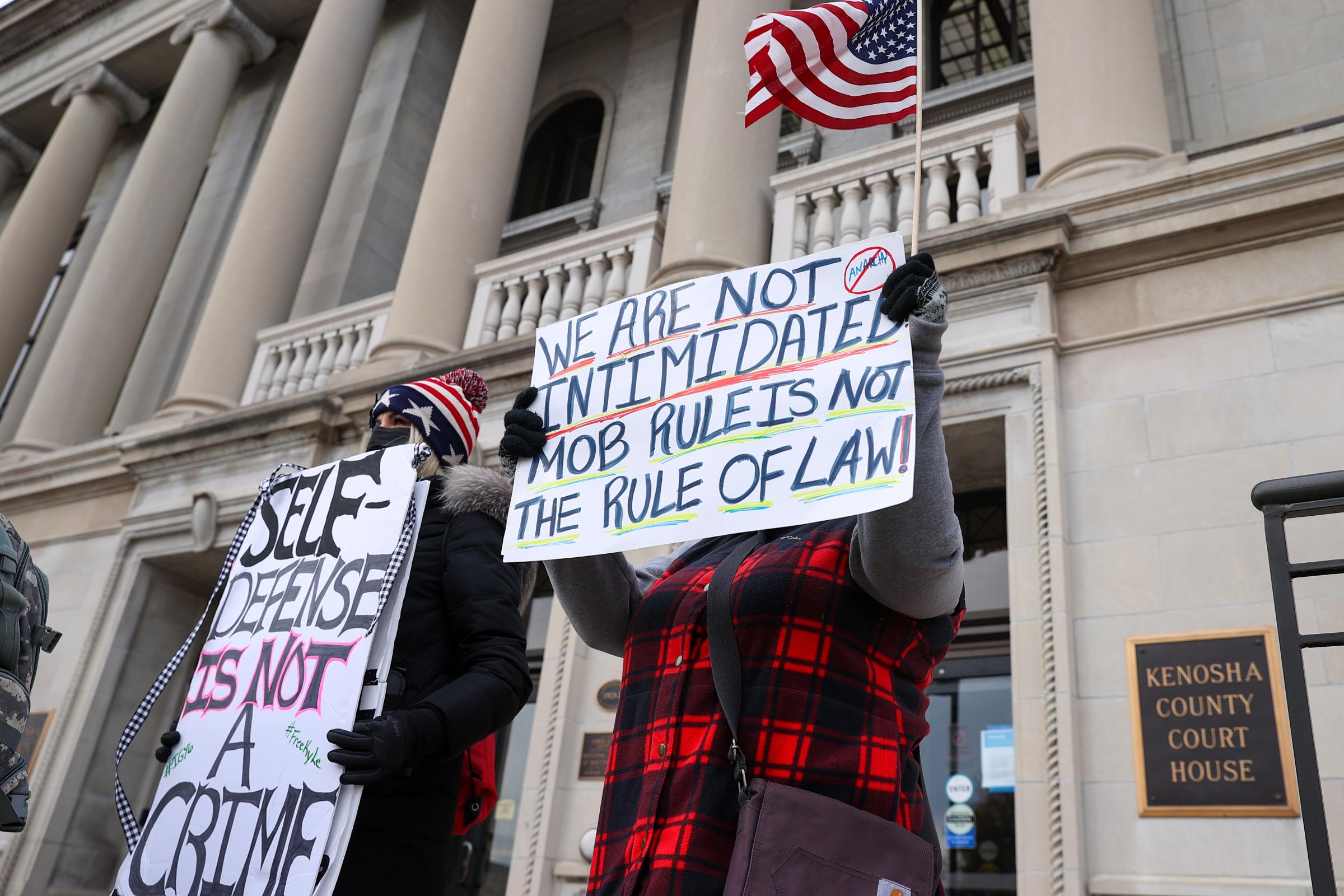Jurors in Kyle Rittenhouse’s polarizing murder trial agreed with the defense that the teenager acted in self-defense when he shot three people during protests in Wisconsin last year, but self-defense claims are rarely as clear-cut as they might appear.
During two weeks of testimony, prosecutors and the defense painted opposing pictures of Rittenhouse, who was 17 when he killed two men and injured another as protests against police brutality erupted in Kenosha, Wisc., on Aug. 25, 2020. Rittenhouse, in a rare move, took the stand in his own defense and said he opened fire because he feared for his life, killing Joseph Rosenbaum, 36, Anthony Huber, 26, and wounding 27-year-old Gaige Grosskreutz.
“I did what I had to do,” he told the court.
His attorney, Mark Richards, claims Rittenhouse was justified in his actions and that he “didn’t shoot at anyone until he was chased and cornered.” Prosecutors say none of the men who Rittenhouse shot posed imminent threats. Instead, they say Rittenhouse lost the right to claim self-defense because he provoked the attacks and created his own danger when he brought a semi-automatic rifle to the protests, crossing state lines from Illinois to do so.
A tangle of factors
Criminal defense attorneys say jurors face a tangle of factors in self-defense cases, including the circumstances of the incident, the state law on what constitutes self-defense, and often the politics and emotions surrounding the case. This one was no different, and it split followers of the trial into two camps: those who believe Rittenhouse is a hero and those who say he instigated the violence.Jury verdicts heavily rely on self-defense laws, which vary by state.
At least 30 have so-called Stand Your Ground laws, which allow people to use deadly force for protection when reasonable, according to the Giffords Law Center, a gun-safety group. Joseph Tully, a California criminal defense attorney, says those laws typically make it much easier to win self-defense claims because the defense does not have to show that retreat was an option. Other states, including Wisconsin, have more specific requirements.
Was Rittenhouse a selfless individual who went to Kenosha as a public servant? Or did he go there looking for trouble?
Under Wisconsin law, a person is permitted to use deadly force in self-defense if the threat he or she is facing is equally as deadly, according to Michael O’Hear, a Marquette University Law School professor in Wisconsin. That meant the jurors had to decide if Rittenhouse really believed he faced a lethal threat at the time, and if that belief was reasonable. That’s a challenging task because it’s so open-ended, O’Hear says. But there’s an extra layer the jury has to work through. In Wisconsin, O’Hear says, if you provoke the attack, you’re prohibited from using deadly force unless you first exhaust every alternative.
“The jury really is in a position here to weigh those competing narratives,” O’Hear said as deliberations were under way. “Was Rittenhouse a selfless individual who went to Kenosha as a public service? Or did he go there looking for trouble?”

The Rittenhouse trial was the first major race-related case to reach a jury since former Minneapolis police officer Derek Chauvin was convicted in April of murdering George Floyd. Rittenhouse and the three men he shot are all white, but racial injustice protests brought them together that night after a white Kenosha police officer shot Jacob Blake, a Black man, two days earlier. Those kinds of circumstances might add pressure on a jury to reject a self-defense claim and convict, says Tully, who has won several self-defense cases. “The political factors are the biggest factors,” he says, adding that potential negative views about guns and the use of firearms for self-defense could also play a role.
“The average person wouldn’t say, if you’re in danger, pull out a gun and shoot someone,” Tully says.
‘A tough call’
In one of the most famous verdicts from a self-defense case, a Florida jury acquitted George Zimmerman of all charges in 2013 after attorneys for the neighborhood watch volunteer claimed he acted in self-defense when he fatally shot Trayvon Martin, an unarmed black teenager.
As the Rittenhouse jury entered a second day of deliberations Wednesday, even Mark O’Mara, who one was one Zimmerman’s self-defense attorneys, had no idea what to expect. “It’s going to be a tough call,” he said.
O’Mara sees similarities between Zimmerman’s trial and Rittenhouse’s, including the division both cases caused. Prosecutors in both cases argued that the defendants were wannabe authority figures. But there are some differences. Zimmerman’s encounter with Trayvon Martin was not recorded on video, whereas nearly every second of Rittenhouse’s confrontations with the three men was captured and played in court. How the men put themselves in those situations slightly differed, too. O’Mara says Zimmerman was on his way to Target when he stumbled upon Martin, while Rittenhouse was “wandering around like he’s playing G.I. Joe.”
“In my opinion, that’s much more egregious than Zimmerman,” O’Mara says.
Self-defense cases, like Rittenhouse’s, are so hard to argue, O’Mara says, because someone is dead in the end, and that can be an emotional and tough thing to justify to 12 jurors. Besides the death penalty for convicted prisoners, he says, the only other way to legally kill someone in the U.S. is in self-defense.
“You have intentionally decided to take another human life,” O’Mara says. “And, ladies and gentlemen of the jury, it’s OK because I’m allowed to.”
Rittenhouse, now 18, faced a mandatory sentence of life in prison if convicted of the most serious charge of first-degree homicide.
More Must-Reads from TIME
- Inside Elon Musk’s War on Washington
- Meet the 2025 Women of the Year
- The Harsh Truth About Disability Inclusion
- Why Do More Young Adults Have Cancer?
- Colman Domingo Leads With Radical Love
- How to Get Better at Doing Things Alone
- Cecily Strong on Goober the Clown
- Column: The Rise of America’s Broligarchy
Contact us at letters@time.com